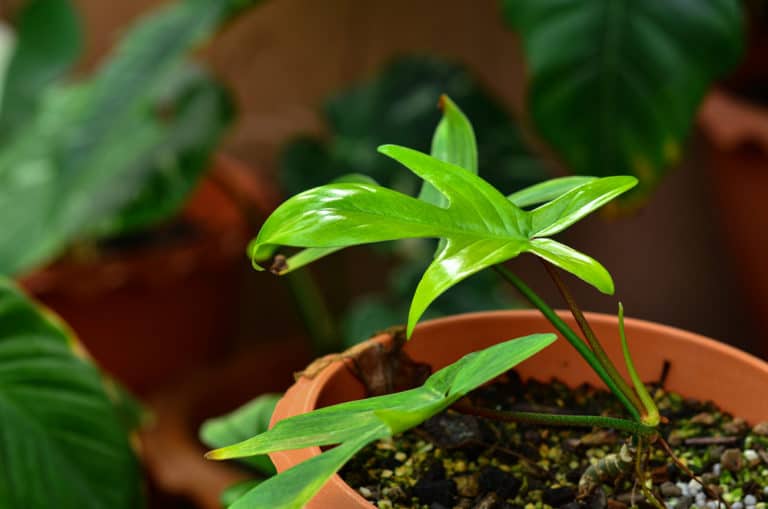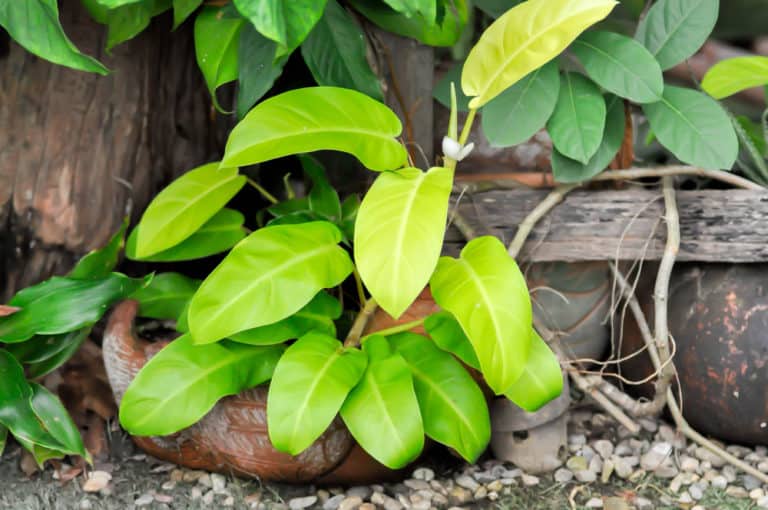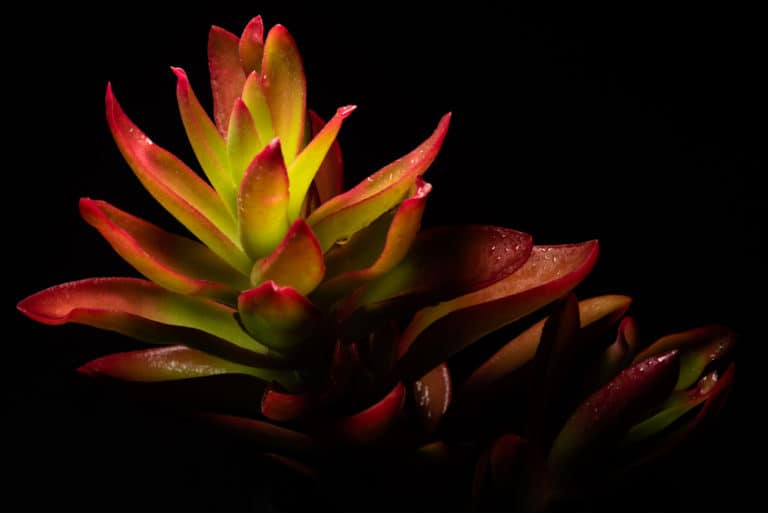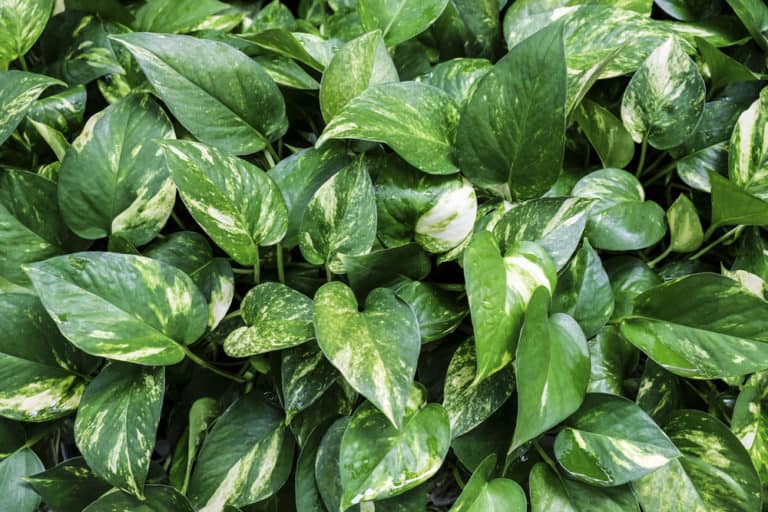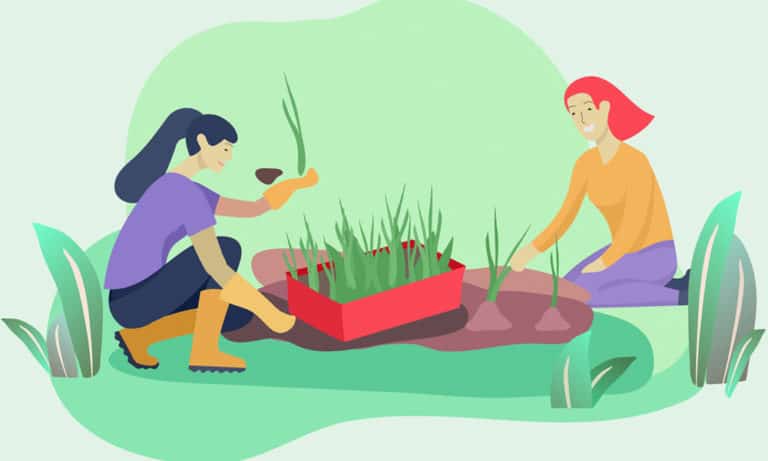Peperomia Argyreia ‘Watermelon’ Care Guide (2024)
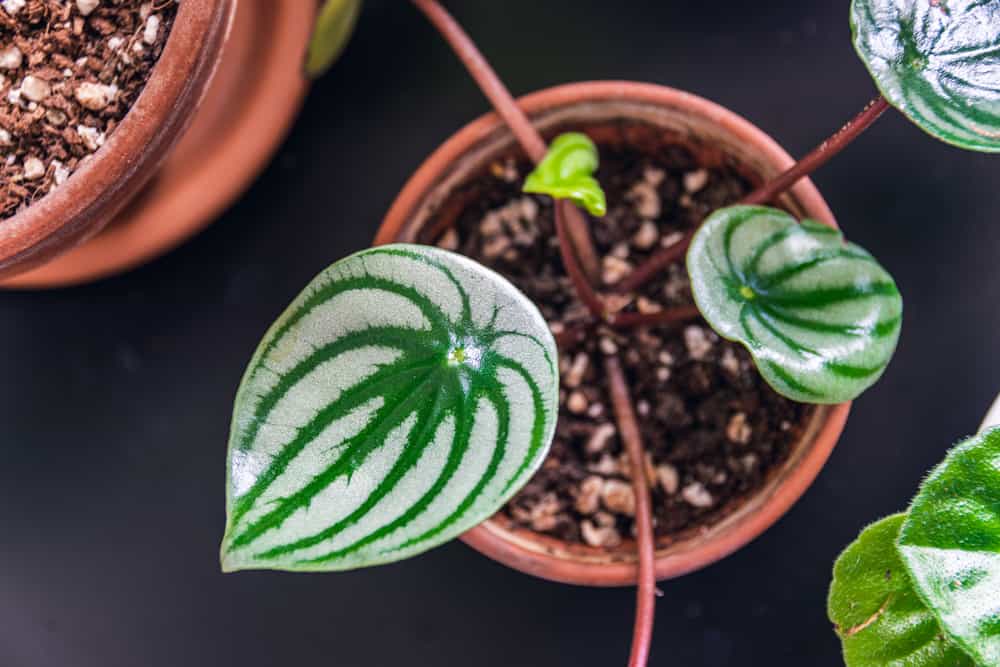
The watermelon Peperomia plant is currently very trendy amongst house plant enthusiasts.
While Peperomia argyreia is a naturally occurring cultivar, no one is quite sure of when it was first grown as a potted plant.
However, it’s long been popular in Brazil as a housewarming gift, and now it’s turning up in homes all over the world.
| Scientific Name | Peperomia argyreia |
| Common Name | watermelon Peperomia, Watermelon Begonia |
| Light | Bright indirect sunlight |
| Watering | Water if the top inch of soil is dry |
| Temperature | 65-75ºF (18-24ºC) |
| Hardiness Zone | 10 to 12 |
| Humidity | 40 to 50% |
| Soil Type | Rich, quick-draining, loamy |
| Soil pH | 6 to 7 (mildly acidic to neutral) |
| Fertilizing | A balanced feed once a month in spring and summer |
| Repotting | Every 2 to 3 years |
| Pruning | Beginning of the growing season |
| Propagation | Division or leaf cuttings |
| Toxicity | Not toxic to humans and pets |
| Mature Size | 6 to 12 inches as a houseplant |
| Bloom Time | Summer |
What’s Unique About Watermelon Peperomia?
The watermelon Peperomia plant is native to the equatorial rainforests of Brazil, Venezuela, Ecuador, and Bolivia, where it grows on the forest floor.
Recently, watermelon Peperomia plants have become one of the must-have tropical plants for indoor gardeners because of their striking foliage.
The large leaves have broad green and silver stripes that resemble the skin of a ripe watermelon.
Growing watermelon Peperomia is pretty easy, as it will thrive as long as you keep it watered and in a warm, bright location.
Another bonus is that the watermelon Peperomia filters a big percentage of formaldehyde out of your indoor environment.
Watermelon Peperomia Care
In the hot tropical rainforests where watermelon Peperomia originates, it grows on the forest floor under the tree canopy.
Your watermelon Peperomia plant care needs to take the native habitat of this tropical plant into account.
Luckily, it’s not too hard to provide good Peperomia argyreia care: keep your plant in a bright, warm spot out of the full sun, and water it regularly.
Light
The equatorial sun shining directly overhead can be punishingly bright.
However, the tree canopy of the rainforest filters the hot rays before they reach the forest floor where watermelon Peperomia grows.
As a consequence, watermelon Peperomia light requirements are for bright but indirect light, or between 10,000 to 20,000 lux.
It’s usually easy to meet your Peperomia argyreia light needs without resorting to supplementary lighting.
A good spot for your watermelon Peperomia is a north or east-facing window, where the sunlight will never be too strong.
However, if all you have are south or west exposures, you will need to place your watermelon Peperomia back several feet from the windows to avoid the full sun.
Watering
On the floor of the tropical rainforest, the watermelon Peperomia grows in soil that is always moist but never saturated.
In your home, watermelon Peperomia watering should replicate those conditions.
Water Peperomia argyreia whenever the top inch of the soil has dried out.
Gently pour tepid water over the entire soil surface until it has absorbed all it can and the excess is draining out the bottom.
Your watermelon Peperomia’s watering needs are best fulfilled with distilled or rainwater, as the chemicals in tap water can be harmful.
If you have no choice, let the tap water sit overnight to give the fluoride and chlorine an opportunity to gas off.
Temperature
It’s not a big surprise for a tropical plant that the watermelon Peperomia temperature range is 65-85ºF (18-29ºC).
You can let the nighttime temperature for Peperomia argyreia drop to about 60ºF (15ºC), but it does not have much temperature tolerance below 50ºF (10ºC).
Even if your house is heated, you need to be careful to keep it out of drafts and away from cold windows in the window.
If your watermelon Peperomia starts dropping its leaves, it’s probably too cold.
The watermelon Peperomia has no frost hardiness at all, so if you take it outside for the summer, bring it in before things cool down.
Humidity
The watermelon Peperomia humidity requirements are moderate and can usually be met easily in your home.
The ideal humidity for Peperomia argyreia is about 40 to 50%.
In fact, too high a humidity level can lead to issues with fungus, so it’s important to keep it out of overly humid locations such as bathrooms.
However, if the leaves start to split a bit, that’s a sign that the humidity is too low, so either mist the leaves every few days or set the pot on a pebble tray filled with water.
All your tropical plants can benefit from a small humidifier to moisten the air.
Soil
On the floor of the rainforest, watermelon Peperomia grows in spongy, well-draining soil full of organic matter.
When growing this tropical plant in your home, you need a similar watermelon Peperomia soil.
The best pH level for Peperomia argyreia is 6 to 7, or mildly acidic to neutral.
You can use a commercial African Violet soil mix for your watermelon Peperomia, as they have very similar soil requirements.
Standard indoor potting soil should be amended with peat moss or perlite to improve its draining abilities.
Another good soil for Peperomia argyreia is a mix of equal parts of peat moss, compost, and perlite.
Fertilizer
The watermelon Peperomia is not a heavy feeder, but will appreciate a light feeding in the spring and summer.
Use a liquid houseplant fertilizer for Peperomia argyreia with a fertilizer ratio ratio of 20-20-20.
To apply watermelon Peperomia fertilizer properly, dilute the liquid formula to half the recommended strength.
Pour it over the soil surface evenly shortly after you’ve watered. This will ensure even absorption.
Sometimes you may see a white crust on the soil surface. That’s a sign that salts from the fertilizer are building up in the soil, and it can damage the roots.
Flush the salts out by running a stream of water through the soil for about 10 minutes.
Potting & Repotting
Repotting Peperomia argyreia is only necessary every 2 to 3 years, as it grows slowly and doesn’t mind being a bit rootbound.
However, when you start to see roots growing out of the drainage holes, it’s time for watermelon Peperomia repotting.
Only go up one pot size when moving it on to a new home, as too much soil in relation to its roots will actually harm its growth.
Choose a new pot with drainage holes. Glazed or unglazed pottery, or a sturdy plastic pot, will work.
Always use fresh potting soil. In fact, you may not have to change pots but should still give it new growing medium.
Pruning
It is possible that the only watermelon Peperomia pruning you ever need to do is to remove dead or damaged leaves.
These can harbor pests and disease, and also mar the appearance of this lovely plant.
The watermelon Peperomia grows slowly, and naturally forms a small, bushy shape without any assistance.
When cutting Peperomia argyreia leaves, cut the entire stem out at the soil surface, as an old stem will not sprout a new leaf. New stems will emerge and unfurl fresh leaves.
Trim your watermelon Peperomia with sharp, sterilized scissors, and do not leave the cut foliage on the soil.
Propagation
You can propagate Peperomia argyreia easily using a few different methods. Spring is the best time to do this.
The easiest watermelon Peperomia propagation method is root division.
When you see offshoots popping up around the perimeter of the mother plant, remove the root ball from its pot. Gently tug off the plantlets (or pups) and plant each one in its own pot.
Another fun way to propagate watermelon Peperomia is with leaf cuttings.
Cut off a leaf, and then cut it half, either vertically or horizontally. Then nestle the cut side of the halves shallowly into a tray or pot of moist soil.
Cover them with a plastic bag or dome, and within a few weeks you should start to see new plants sprouting along the leaf.
Common Problems of Watermelon Peperomia
Like with all houseplants, watermelon Peperomia problems are more likely to arise when you are not providing it with good enough growing conditions.
Luckily, most problems with Peperomia argyreia can easily be identified and resolved.
The leaves are the key to its health; when the foliage is suffering, it’s time to find out what is wrong.
Pests
Most watermelon Peperomia pests can be deterred with a monthly application of an insecticidal soap or neem oil solution. Just spray it on or wipe down the leaves with a damp cloth.
Peperomia argyreia is prone to infestation by most common houseplant bugs.
Fungus gnats are attracted to damp soil. Use a yellow sticky trap to catch the adults, and drench the soil with a mixture of 1 part 3% hydrogen peroxide to 4 parts water.
Mealy bugs look like small tufts of cotton under the leaves, Wipe them off with rubbing alcohol.
Scale attach themselves to the stems and leaves. Scrape them off carefully.
Aphids are small green bugs on the stems and underside of the leaves. Rinse them off in the sink.
Diseases
The most common of watermelon Peperomia diseases is root rot. This is likely to develop if you have left your watermelon Peperomia sitting in wet soil.
If the leaves of your Peperomia argyreia are drooping and yellowing, and the stems are starting to rot, pull the root ball out of its pot.
If some of the roots are black, you may still be able to save your watermelon Peperomia.
Cut off all the rotting roots, stems, and leaves, and replant what’s left in fresh soil in a new pot.
Unfortunately, if all the roots have turned black, it’s too late for your watermelon Peperomia.
Growing Problems
If your watermelon Peperomia has growing problems, it’s probably a result of poor growing conditions. Once you’ve adjusted that, your sick plant should get better.
Inward-curling leaves could mean that your watermelon Peperomia’s soil is too dry, or that it’s getting too much sun.
Drooping leaves are usually an indication of low soil moisture.
Small leaves on long, leggy stems are a sign that your watermelon Peperomia isn’t getting bright enough light.
Dropping leaves are usually caused by too cold a location.
Splitting leaves can be a symptom of low humidity or a calcium deficiency. Crushed eggshells may help with the calcium.
Toxicity of Watermelon Peperomia
Not only is Peperomia argyreia compact and perky, but it’s also not toxic to humans or animals.
Its lack of toxicity means that you can easily grow it in households with children and pets, without fear of medical emergencies from ingestion.
However, as a rule, it’s a good idea to discourage too much contact with any houseplant.
For Humans
Because watermelon Peperomia is not toxic to humans, you don’t have to take any precautions when handling this plant.
However, even though it is non-toxic, it’s still not a good idea to let your children handle it.
Any products such as insecticides or fertilizer that you use on your watermelon Peperomia are not recommended for contact with children.
As well, they will not be able to easily distinguish between plants that are safe and those that aren’t, such as philodendrons or rubber plants.
Luckily, it’s easy to find a spot for this compact potted plant on a high shelf or table out of reach of little hands.
For Pets
While watermelon Peperomia is not toxic to household pets, including cats, dogs, and rabbits, that does not mean it’s completely without issues.
Cats and dogs are carnivores whose digestive systems have evolved to deal with meat and small quantities of vegetable material.
Eating too much foliage of any plant can lead to gastrointestinal symptoms including vomiting and diarrhea.
While it’s not something that requires an emergency vet visit, it is going to cause a fair amount of distress for your pet, and a messy situation for you.
As well, cats especially are notorious for inflicting damage on houseplants.
It’s best to keep both your pets and plants safe by keeping them apart.
Watermelon Peperomia Appearance
The perky, bright watermelon Peperomia appearance is sure to find a spot in even the smallest of homes.
Growing to only a compact 12 inches high, it will fit on a ledge or table and never get too big.
While watermelon Peperomia may bloom, the flowers are nowhere near as attractive as its beautifully striped leaves.
Foliage
The foliage of watermelon Peperomia puts on a great show year-round.
The evergreen leaves have broad silver and green stripes that look just like the stripes on a watermelon, hence its common name. The undersides are a pale green.
Each leaf attaches to its red petiole on the underside of the leaf, creating a small yellowish dimple that the stripes radiate out from.
Leaves grow about 3.5 inches long and across, and are thick and leathery with a waxy texture.
You should wipe down the leaves once a month or so to clean off any accumulated dust and grime.
Flowering
While you may get to see your watermelon Peperomia flowering, it’s really not that spectacular.
Flowers can appear on watermelon Peperomia plants grown indoors or outdoors.
A Peperomia argyreia flower is a thin greenish spike on a red stem, which rises up above the clump of foliage. Several may be blooming at the same time, usually in early summer.
While it has some botanical interest, the flower is not particularly striking, and does not even have any scent.
Many growers simply cut off the flower spikes before they bloom to redirect the watermelon Peperomia’s energies to the production of leaves instead.
Size and Growth
The small size of watermelon Peperomia is one of its advantages for indoor gardeners with limited space.
The watermelon Peperomia plant has a slow growth rate, taking 3 years to reach its maximum size of 12 inches height and spread. Many plants will not reach even that low height.
Leaf stems emerge from the central crown, forming a compact, bushy shape.
New plantlets are likely to spring up around the perimeter of the crown. These can be left in place to create an even bushier look, or divided to propagate new plants.
Your watermelon Peperomia does not need to be staked, as the rigid stems are self-supporting.
Watermelon Peperomia Fragrance
There is no watermelon Peperomia fragrance.
The evergreen foliage of watermelon Peperomia is fragrance-free, and the summer-blooming flowers have no scent.
However, watermelon Peperomia does have a very beneficial impact on your indoor environment.
In a NASA study, Peperomia plants have been found to remove 47% of formaldehyde from the air. Our modern homes have many products emitting that and other noxious chemicals.
As well, scentless plants like the watermelon Peperomia are perfect for using in settings where people with fragrance sensitivities might be exposed.
Many institutions such as nursing homes actually prohibit heavily-scented plants, and you might even prefer that in a small apartment or office.
Suggested Uses for Watermelon Peperomia
Indoors or outside, you’ve got lots of ways to use a watermelon Peperomia around your home.
Because it’s non-toxic and a great air cleaner, keeping one by your bedside is perfect, especially as it won’t take up a lot of room.
You can even plant it in a hanging planter and not take up any floor or shelf space at all.
Outdoors in a tropical climate, watermelon Peperomia makes a great mass planting, and its evergreen leaves will look great all year.
In a temperate zone, you can move your watermelon Peperomia outdoors for the summer to bask in the hot weather.
FAQ
What is watermelon Peperomia?
The watermelon Peperomia plant is a native of the tropical rainforests of South America, where it grows on the forest floor. It is now a popular houseplant.
How to identify watermelon Peperomia?
The watermelon Peperomia plant has 3.5-inch leaves with broad stripes of green and silver. It is a compact, bushy plant with a rounded shape.
How to care for watermelon Peperomia?
The watermelon Peperomia plant should be grown in bright, indirect light, in rich but well-draining soil that is kept consistently moist in a warm environment with moderate humidity.
How to grow watermelon Peperomia indoors?
The watermelon Peperomia plant can be grown as a potted plant in a bright location out of the full sun and kept warm and out of drafts.
How to grow watermelon Peperomia outdoors?
The watermelon Peperomia plant can be grown as a landscape or container plant year-round in tropical climates or brought outdoors in summer in temperate zones.
How fast does watermelon Peperomia grow?
The watermelon Peperomia plant is a fairly slow grower, as it takes 3 years to grow to its full height of 12 inches or less.
How tall does watermelon Peperomia grow?
The watermelon Peperomia plant can sometimes reach a full height and spread of 12 inches, although some plants only grow to about 8 inches tall.
How to make watermelon Peperomia grow faster?
The watermelon Peperomia plant will grow its fastest when kept in the brightest possible location out of the direct sun in hot temperatures. Extra fertilizer will not spur growth.
How to stake watermelon Peperomia?
The watermelon Peperomia plant does not need to be staked, as the stems grow upright without additional support. You should rotate the pot once a week to prevent it from developing a lean.
How to pot watermelon Peperomia?
The watermelon Peperomia plant should be planted in well-draining soil with lots of organic matter that will retain moisture in a pot with good drainage holes.
How to revive watermelon Peperomia?
If a watermelon Peperomia plant is limp from lack of water, it can be revived by soaking the pot in tepid water until the soil is saturated and then draining out excess water.
Why is my watermelon Peperomia dying?
Your watermelon Peperomia plant can develop root rot if the pot sits in water, keeping the soil saturated. Cut out all affected parts and repot.
Why is my watermelon Peperomia drooping?
Your watermelon Peperomia plant may be drooping because it is under or overwatered. Check the soil moisture levels and either water thoroughly or replant in fresh, porous soil.
How cold can watermelon Peperomia tolerate?
The watermelon Peperomia plant can tolerate temperatures as low as 50ºF (10ºC), but below that it will drop leaves, and freezing temperatures will kill it.
How to get rid of pests on watermelon Peperomia?
Common watermelon Peperomia plant pests can be kept away by spraying or wiping down the leaves with insecticidal soap or neem oil solution every month.
Is watermelon Peperomia toxic to cats?
No, the watermelon Peperomia plant is not toxic to cats. However, cats are carnivores and they can have vomiting and diarrhea if they eat too much foliage.
Is watermelon Peperomia toxic to dogs?
No, the watermelon Peperomia plant is not toxic to dogs. However, dogs can suffer gastrointestinal symptoms if they eat too much, as they have trouble digesting plants.
Is watermelon Peperomia toxic to children?
No, the watermelon Peperomia plant is not toxic to children, but even organic insecticides and fertilizers are not safe to ingest. Discourage children from handling any houseplant.
Is watermelon Peperomia toxic to humans?
No, the watermelon Peperomia plant is not toxic to humans at all, so you do not need to take any precautions when working with it.
Does watermelon Peperomia have a scent?
Neither the watermelon Peperomia foliage nor flowers have any scent, so they are safe to use in any setting where sensitive individuals might be exposed to it.

